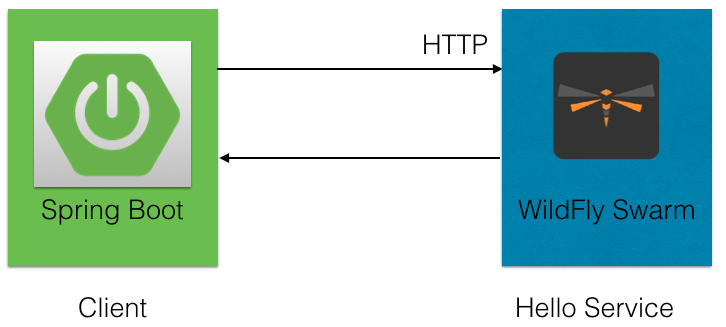fabric8-hello
Two microservices using Spring Boot and WildFly Swarm with Camel running in kubernetes using fabric8 tooling
There are three Maven projects:
- client - Spring Boot application with Camel that triggers every 2nd second to call the hello service and log the response. The client uses Camel client side retry for error handling.
- client-hystrix - A client that uses Hystrix as circuit breaker for error handling.
- helloswarm - WildFly Swarm application hostin a hello service which returns a reply message.
The diagram below illustrates this:
Running Kubernetes locally
The applications can be deployed in a kubernetes cluster. You can run a kubernetes cluster locally using fabric8 which you can find more details here: fabric8 get started
Installing from Maven
The fabric8 team has made it very easy to download, install and start a Kubernetes/OpenShift cluster on your computer very easy. All you need to do is from a command line run this Maven goal:
mvn io.fabric8:fabric8-maven-plugin:3.2.9:cluster-start
And if you want to use OpenShift instead of Kubernetes:
mvn io.fabric8:fabric8-maven-plugin:3.2.9:cluster-start -Dfabric8.cluster.kind=openshift
Then fabric8 will download the binaries into <HOME>/.fabric8/bin directory. It can be a good idea to add this directory to the $PATH, so you can easily run the clients to interact with the cluster.
However before we had to install fabric8 using a few more manual steps as explained below.
Manually steps
I am using MiniShift to run my local kubernetes cluster. I run the minimal version which do not include the CI/CD pipeline and therefore I run with low memory usage.
minishift start --memory=2000
... and follow the instructions from minishift.
And then I have installed fabric8 using gofabric8:
gofabric8 deploy -y --console
... and follow the instructions from fabric8.
If all this is sucesfull you can open the fabric8 web console using:
gofabric8 consoole
Slides
This source code is used for a talk at various conferences, and you can find the slides for the talks in the slides directory.
Prepare shell
When using Maven tooling you want to setup your command shell for docker/kubernetes which can be done by
gofabric8 docker-env
Which tells you how to setup using eval
eval $(minishift docker-env)
Deploying WildFly Swarm (server)
You can deploy the WildFly Swarm application which hosts the hello service.
cd helloswarm
mvn install
If the build is success you can deploy to kubernetes using:
mvn fabric:deploy
Deploying Spring Boot (client)
You can deploy the Spring Boot application which is the client calling the hello service
cd client
mvn install
If the build is success you can deploy to kubernetes using:
mvn fabric:deploy
You should then be able to show the logs of the client, by running oc get pods and find the name of the pod that runs the client, and then use oc logs -f pod-name to follow the logs.
However you can also run the application from the shell and have logs automatic tailed using
mvn fabric:run
And then when you press cltr + c then the application is undeployed. This allows to quickly run an application and stop it easily as if you are using mvn spring-boot:run or mvn wildfly-swarm:run etc.
